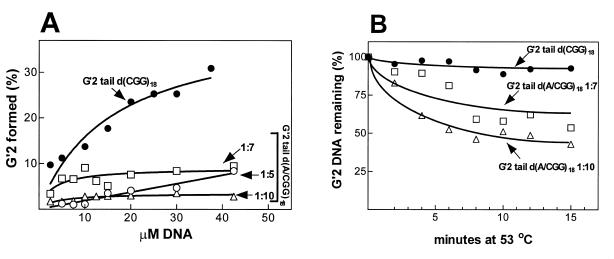Figure 2.
Interspersed d(AGG) trinucleotides diminish the formation and stability of G′2 tetraplex forms of 3′-tail d(CGG)18 oligomers. (A) Extent of formation of tetraplex structures by monotonous and d(AGG)-containing d(CGG)n oligomers. Increasing concentrations of 5′-32P-labeled oligomers: tail d(CGG)1 8; tail d(A/CGG)18 1:5; tail d(A/CGG)18 1:7; and tail d(A/CGG)18 1:10 were incubated at 55°C for 20 h in the presence of 500 mM NaCl. The reaction mixtures were diluted and electrophoresed through a non-denaturing 8% polyacrylamide gel as detailed in Figure 1. Proportions of rapidly migrating single-stranded DNA and retarded tetraplex DNA were quantified by phosphorimaging. (B) Kinetics of heat denaturation of monotonous and d(AGG)-containing d(CGG)18 oligomers. G′2 tetraplex DNA structures of the indicated 5′-32P-labeled oligomers were formed as in (A), suspended in 50 mM NaCl and incubated at 53°C for the indicated periods of time. The rapidly cooled DNA samples were resolved at 4°C by non-denaturing electrophoresis through a 8% polyacrylamide gel and amounts of remaining G′2 tetraplex DNA structures were quantified by phosphorimaging analysis as in (A).

